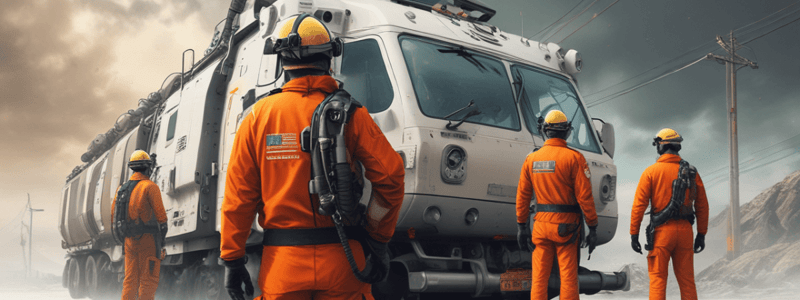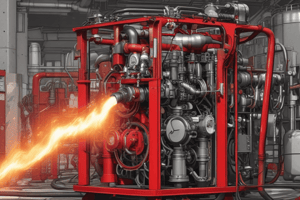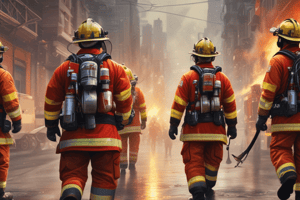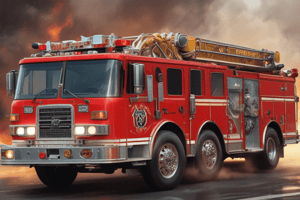Podcast
Questions and Answers
What is an advantage of the reverse lay tactic?
What is an advantage of the reverse lay tactic?
- Less pump redundancy with a pumper at the hydrant
- More likelihood to block the scene with LDH and supply line
- Less combat-ready personnel on scene for initial operations
- Enhanced water flow capacity with a pumper at the hydrant (correct)
Why might reverse lay not be viable in certain situations?
Why might reverse lay not be viable in certain situations?
- Due to lack of hydrant location and street grinding (correct)
- Due to lack of personnel to implement the tactic
- Due to the complexity of the tactic
- Due to the need for more equipment
What is the primary disadvantage of Plan C: Forward Lay by Second Engine?
What is the primary disadvantage of Plan C: Forward Lay by Second Engine?
- It requires more personnel to implement
- It requires an individual to charge the hydrant (correct)
- It provides less water for initial operations
- It is not effective in certain street layouts
What is the benefit of having a pumper at the hydrant in the reverse lay tactic?
What is the benefit of having a pumper at the hydrant in the reverse lay tactic?
What is the total amount of available water for initial operations in Plan C?
What is the total amount of available water for initial operations in Plan C?
Why is Plan D: Forward Lay by First-Due Engine not ideal?
Why is Plan D: Forward Lay by First-Due Engine not ideal?
What is an advantage of the reverse lay tactic compared to Plan D?
What is an advantage of the reverse lay tactic compared to Plan D?
What is a situation where the reverse lay tactic is ideal?
What is a situation where the reverse lay tactic is ideal?
What is the purpose of sharing the booster tank water in Plan C?
What is the purpose of sharing the booster tank water in Plan C?
What happens if the attack pumper has a mechanical issue in the reverse lay tactic?
What happens if the attack pumper has a mechanical issue in the reverse lay tactic?
Flashcards are hidden until you start studying
Study Notes
Engineer Roles and Responsibilities
- Engineers may need to think and act independently and outside of their skillset in situations like correcting errors with the apparatus or operating an aerial in a high-rise rescue.
- Practicing all the skillsets of the Engineer position is critical to successful incident mitigation.
Pump Chart Introduction
- The purpose of a pump chart is to provide pump operators with a shortcut to calculate the total Pump Discharge Pressure (PDP) needed for effective firefighting.
- The pump chart takes into account factors like friction loss in a hose line, which varies based on manufacturing processes, materials, temperature, wear, and age.
Pump Chart Components and Best Practices
- The pump chart provides values for pump operators to calculate PDP, including friction loss and elevation.
- The single most important skill to master is learning how to read a table to find values.
- The curriculum includes examples and best practices from St. John's Fire District operational guidelines.
Changes to the Pump Chart
- The replacement of the Chief Fog nozzle with the 7/8" smoothbore nozzle on attack packages.
- Changes to standpipe hose (2.25") and accompanying smoothbore nozzle of 1" and 1-1/8".
- The addition of elevation, including head pressure loss/gain per floor and per foot, to account for head pressure issues within a building or in elevated terrain.
High-Rise Operations
- The Pump Chart includes a section on high-rise operations, with an abridged set of rules for pumping into a FDC (Fire Department Connection) for standpipe-equipped buildings.
- When supplying an FDC or standpipe, the apparatus should position as close as possible to the connection, preferably within 50 feet.
Pump Chart Defensive Operations
- The Pump Chart Defensive Operations section provides a single value for apparatus-mounted master stream devices.
- The Deck Gun and Aerial Waterway utilize an established appliance APPL pressure of 100 psi.
- The flow of these devices is predicated on available hydrant flow in conjunction with nozzle tip diameter.
Pump Chart Offensive Operations
- The Pump Chart includes a section on offensive operations, with different nozzle sizes and corresponding flow rates and nozzle pressures.
- The chart includes friction loss values for different hose sizes and lengths.
Water Supply
- The establishment of water supply is an integral component of effective mitigation.
- Engine companies are encouraged to factor hydrant location into their apparatus placement and either stop short or pull past the fire building.
Water Supply Tactics
- Plan B: Reverse Lay - if the first-due engine is unable to spot within hand-stretch distance of the hydrant, it defers water supply completion to the second-due engine.
- Plan C: Forward Lay by Second Engine with optional Booster Back-up - the second-due engine lays from the hydrant and proceeds to the scene, sharing its booster tank water with the first-due engine.
- Plan D: Forward Lay by First-Due Engine - the typical water supply tactic utilized by the District, but delays the arrival of the first-due engine on scene to assess for life safety considerations.
Studying That Suits You
Use AI to generate personalized quizzes and flashcards to suit your learning preferences.




